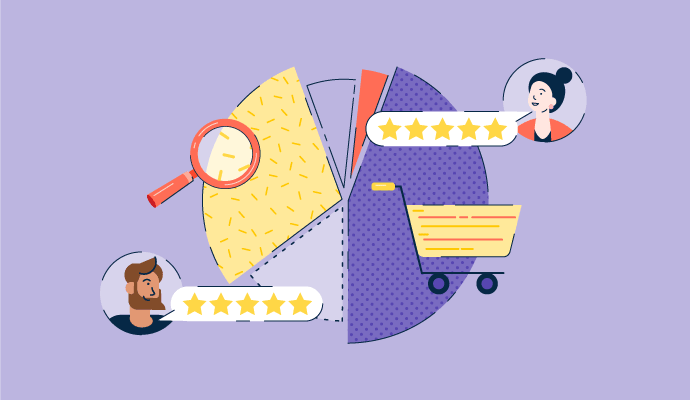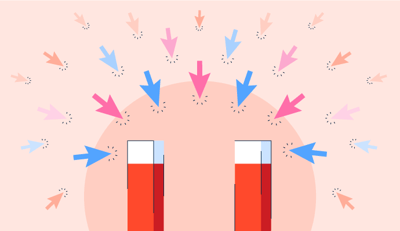This article was originally published in 2020. It has been updated with new information.

So, you launched a marketing campaign, but the ROI was peanuts. You might have been 10/10 for product knowledge, but without a buyer persona, no campaign takes off.While GTM is a way to improve audience retention, engagement, and repeat customers, planning your strategy without mapping a buyer persona mostly ends in vanity.
Website content seems generic and ambiguous, eventually leading to high bounce rates and minimal conversions.
By mapping your buyer persona with relevant customer demographics in an audience intelligence platform, you build a direct channel for content distribution, which in turn improves qualified lead pipeline and, ultimately, conversions. Let's see what a buyer persona is all about.
A buyer persona is a semi-fictional profile that represents your ideal customer based on real data and market research. It includes demographics, behaviors, goals, pain points, and buying patterns. Businesses use buyer personas to align marketing, product development, and sales strategies with customer needs.
Buyer personas are used to tailor messaging, improve product-market fit, and increase conversion rates across channels.
According to a 2024 report by Aspiration Marketing, businesses that use data-driven buyer personas see up to 5× higher click-through rates and generate 18× more revenue from targeted emails compared to non-personalized campaigns.
When grounded in real customer insight, buyer personas don’t just guide messaging — they sharpen your entire go-to-market strategy
The most effective buyer personas aren’t built on guesswork—they’re grounded in research, real conversations, and behavioral patterns. When you identify the right persona, you're not just refining your marketing strategy—you’re building the foundation for better targeting, personalization, and conversion.

Here’s how to gather the insights that bring your persona to life:
The broader your perspective, the stronger your persona. By weaving together feedback from across your funnel—support tickets, sales calls, marketing analytics, and customer conversations—you can craft a profile that’s both accurate and actionable.
A negative (or exclusionary) buyer persona helps you identify the types of customers who are unlikely to convert, retain, or deliver ROI. These profiles help you avoid wasting resources on the wrong fit. Here are some examples
Solid buyer personas begin with smart research. From analyzing behavior to conducting interviews, the goal is to understand not just who your customers are, but what drives their decisions. Use this guide to uncover insights that go beyond surface-level data.
Great buyer personas aren’t imagined, they’re uncovered through thoughtful research and real conversations.
The more clarity you gain upfront, the more precisely you can tailor your messaging, products, and strategy to the people who matter most.
Building accurate buyer personas is only half the battle; the real impact comes from validating them with real-world audience and performance data. Whether you’re mapping customer behavior patterns or refining campaign targeting, exploring the right software can elevate your research strategy.
Explore top audience intelligence platforms or compare marketing analytics software on G2 now.
Once your buyer persona research is complete, it’s time to move beyond bullet points and build a clear, engaging narrative. This story format brings your persona to life, giving teams a memorable, humanized profile they can align with across marketing, product, sales, and service. Here's how to write a data-backed customer persona story using a real-world example.
Let’s say you run a growing network of gyms and yoga studios with on-site smoothie bars. Your target customer? We’ll call her Healthy Heather.
Heather is highly motivated to stay healthy and energized, but her inconsistent schedule creates friction. She can’t commit to regular fitness class times, often ending up alone on cardio machines she dislikes. She’s interested in yoga but can’t find a schedule that fits.
When it comes to food, she avoids fast or processed options and seeks out organic, nutritious meals. The problem? She doesn’t always have time to prep them.
Heather’s decisions are informed by a mix of professional and social sources. She reads industry-related journals, consults peers in healthcare, and follows a small circle of fitness-savvy friends. Online, she browses Pinterest for recipes, stays casually active on Instagram, and maintains a basic presence on LinkedIn.
Facebook’s not her go-to, but she’ll check event invites or family updates there occasionally.
When choosing a gym or studio, Heather values flexibility above all, drop-in class options, extended hours, and minimal wait times. She prefers instructors with visible credentials and experience, and she’s willing to pay more for services that respect her time and align with her values.
She’ll drive 20 extra minutes for the right fit if it means a better class experience and healthier snack options on the go.
For Heather, your gym’s promise has to go beyond machines. She’s looking for engaging, instructor-led classes available on a flexible schedule. Also, she needs certified instructors who feel like partners, not just employees. And lastly, she needs easy access to smoothies or nutritious snacks when the time is right.
If your gym can meet her where she is, emotionally and logistically, you’re not just offering convenience. You’re becoming an essential part of her routine.
Turning your buyer persona into a compelling narrative helps internal teams move beyond checkboxes and demographics. You give them a real person to market to, sell to, and build for. When your teams know Heather, they can speak to her needs, address her frustrations, and show up in the moments that matter.
Buyer personas may start as marketing tools, but their real power is unlocked when they’re shared and applied across the organization. Sales, product, and customer success teams can all use persona data to improve targeting, strategy, and outcomes at every stage of the customer lifecycle.
Here’s how each team benefits from a well-built buyer persona:
Make sure your personas are easily accessible, frequently updated, and translated into clear, actionable insights for every team. Better alignment leads to better experiences, and better business outcomes.
A good buyer persona is a strategic advantage. A bad one? A distraction that leads to misaligned messaging, missed opportunities, and wasted resources. Here are some of the most common mistakes companies make when building personas—and how to avoid them.
If you avoid these traps, your buyer personas will remain useful, aligned, and built to drive action—not just awareness.
A buyer persona is a semi-fictional profile based on data that represents your ideal customer. Marketers use it to personalize messaging, target campaigns more effectively, and align content with audience needs.
Core components include demographics, goals, pain points, behavior patterns, buying triggers, and preferred communication channels. These elements help teams understand how and why people make purchasing decisions.
Use a mix of qualitative and quantitative research: CRM data, customer surveys, interviews, lead forms, and sales feedback. Combining these sources helps create an accurate and actionable profile.
A buyer persona represents the ideal customer you want to attract. A negative persona highlights individuals who are unlikely to convert, cost too much to support, or aren't a good business fit.
Start with one core persona, especially if you're early-stage. Most companies benefit from 2–3 well-defined personas representing distinct audience segments.
Yes, sales, product, and customer success teams all use personas to improve messaging, prioritize features, and tailor onboarding. Personas ensure alignment across the entire customer journey.
A strong example is 'Healthy Heather,' a busy professional who values wellness, convenience, and flexibility. Her persona guides marketing for a gym or wellness brand by shaping messaging, offerings, and outreach.
Review buyer personas at least once every 6 to 12 months. Market trends, product changes, and evolving customer behavior can all shift your target audience over time.
By tapping into the right buyer persona, you can better understand audience preferences and personalize your engagement strategies. Buyer persona analysis can help you sharpen the message, identify effective marketing channels, and anticipate obstacles and objections to conversions.
By learning all about your buyer's ideal customer persona, you can set benchmarks and common best practices across your marketing teams to prevent distractions and improve engagement.
Knowing how to create buyer personas is the easy part; the challenge is actually walking through the steps to do it well. Once you do, however, you've laid the groundwork for a much more successful marketing strategy.
Check out this ultimate guide on customer profile and analyze customer psychographics in detail to aim for marketing success.
This article was originally published in 2020. It has been updated with new information.
Shreya Mattoo is a former Content Marketing Specialist at G2. She completed her Bachelor's in Computer Applications and is now pursuing Master's in Strategy and Leadership from Deakin University. She also holds an Advance Diploma in Business Analytics from NSDC. Her expertise lies in developing content around Augmented Reality, Virtual Reality, Artificial intelligence, Machine Learning, Peer Review Code, and Development Software. She wants to spread awareness for self-assist technologies in the tech community. When not working, she is either jamming out to rock music, reading crime fiction, or channeling her inner chef in the kitchen.
When it comes to marketing, you are not your prospect.
 by Washija Kazim
by Washija Kazim
Content marketing plays a key role in both customer acquisition and retention.
 by Neelam Goswami
by Neelam Goswami
Buyer expectations have never been higher. As consumers, purchases are curated and...
.png) by James Kaikis
by James Kaikis
When it comes to marketing, you are not your prospect.
 by Washija Kazim
by Washija Kazim
Content marketing plays a key role in both customer acquisition and retention.
 by Neelam Goswami
by Neelam Goswami


